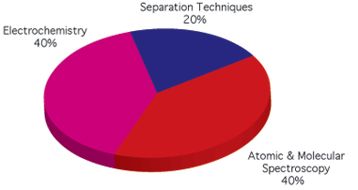Market Profile: Water Analysis and Testing
Water is one of the most abundant compounds found in nature. An estimated 1.4 billion cubic kilometers of water exists on Earth and it covers 70% of our planet’s surface. Water is also a key element to life and makes up 70% of the fat free mass of the human body.
Water is one of the most abundant compounds found in nature. An estimated 1.4 billion cubic kilometers of water exists on Earth and it covers 70% of our planet’s surface. Water is also a key element to life and makes up 70% of the fat free mass of the human body. It is not surprising then that water is used to at least some extent in nearly all industries, and to quite a significant extent in most. The need to analyze water for contaminants, as well as its life supporting characteristics, is nearly as wide.

2007 Water Analysis Market Demand by Technique
When it comes to industrial process water, almost anything present in the water at varying levels can present a potential problem in some industries. One of the biggest examples is the semiconductor and electronics industry, which generally use deionized (DI) water. This water is free of practically anything down to the parts-per-billion (ppb) level because of the scale and resulting sensitivity of modern electronic devices to contaminants. The pharmaceutical industry is another major industrial user of water. Although most final dosage forms of drugs are in solid form, water is a key tool in the manufacturing process of most cases.
Water for human consumption is another area in which water must be constantly monitored, although humans are not nearly as sensitive as electronic circuits might be to contamination. However, the global population is continuing to increase rapidly, while the world’s supply of water holds steady. The increasing worldwide population density and the drive to provide water fit for consumption in developing regions of the world will contribute to the need to invest heavily in potable water infrastructure, as well as the instrumentation needed to monitor it.
Yet another area of concern with regards to water is the environment. With increasing populations there is an increasing volume of wastewater, which, if discharged directly into the environment, can quickly wreak havoc on the ecosystem. Raw wastewater and industrial effluent must be processed and treated before it can be sent back into our lakes, streams and oceans. Therefore it is an area that requires monitoring of both contaminants, as well as its ability to support life.
Such a diverse range of water usage and the resulting variation in purity requirements, have led to the development of a large and incredibly varied market for water analysis instrumentation. In 2007, the worldwide demand for laboratory separations techniques like HPLC, ion chromatography (IC) and gas chromatography (GC) accounted about $800 million for environmental analyses. Moreover, separation techniques represent about a fifth of the water testing market. Overall annual growth has been somewhat modest during the last few years, but demand for individual methods, configurations, and in various geographical regions vary considerably.
The foregoing data was extracted and adapted from SDi's Market Analysis and Perspective report on the Water Testing and Analysis Market: Lab and Process -- Wastewater to Ultrapure Water. For more information, contact Glenn Cudiamat, VP of Research Services, Strategic Directions International, Inc., 6242 Westchester Parkway, Suite 100, Los Angeles, CA 90045, (310) 641-4982, fax: (310) 641-8851, e-mail: cudiamat@strategic-directions.com

Top Execs from Agilent, Waters, and Bruker Take the Stage at J.P. Morgan Healthcare Conference
January 16th 2025The 43rd Annual Healthcare J.P. Morgan Healthcare Conference kicked off in San Francisco earlier this week. Here’s what top executives from Agilent, Bruker, and Waters, discussed during the event.


